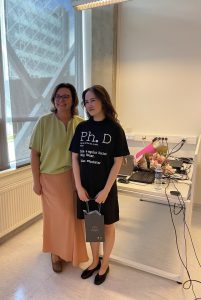On September 1st, 2022 Fariza Kalyk, a PhD student of Faculty of Mathematics and Natural Sciences, has defended her doctoral dissertation and became a new addition to the collective of employees with doctor degree.
The title of the dissertation: Nanostructured Metal Oxides Doped Ceria Ceramics for Low-Temperature Solid Oxide Fuel Cells Application
Technological Sciences, Materials Engineering (T 008)
Supervisor: Assoc. Prof. Dr. Brigita ABAKEVIČIENĖ
Solid oxide fuel cells (SOFCs) are one of the most frequently used groups of fuel cells, which converts large amount of chemical energy to electric power and can operate in a broad range of temperatures (from 400 °C up to 1000 °C). However, high operating temperature reduces a lifetime and mechanical stability of the cell components. The best solution is to reduce the operating temperature. A reliable electrolyte for low-temperature SOFCs (LT-SOFCs) should have high ionic conductivity and low electronic conductivity at low temperatures. This dissertation is devoted to the improvement of the preparation route of the nanostructured ceria-based ceramics for LT-SOFC application, considering the influence of the method of chemical synthesis and the initial metal oxide materials, the dopant, and its concentration, as well as the methods of thin film formation and their parameters. The results presented in this dissertation help to choose a chemical synthesis method, as well as a dopant with the required concentration to obtain electrolyte materials with desired properties. Moreover, the optimal parameters of deposition by the electron beam technology were proposed and implemented. By changing the sintering conditions, the most favourable temperature for GDC thin films was determined. To obtain a completely dense GDC structure without separation of layers by magnetron sputtering, the required number of oxide layers was presented in this dissertation. In addition, electron beam evaporation was used to form a ~700 nm thick GDC diffusion barrier layer on an anode-supported cell for low-temperature µ-SOFC applications.

